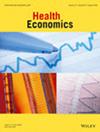机器人对工人补偿福利的影响。
IF 2.4
3区 医学
Q2 ECONOMICS
引用次数: 0
摘要
本文考察了机器人对韩国工伤福利的影响。使用工人赔偿的行政数据,我发现机器人暴露的增加导致每个覆盖工人的平均福利金额显着下降,主要是由于索赔数量的减少,而不是索赔规模的减少。其影响更大,特别是对于永久性残疾等严重病例。本文章由计算机程序翻译,如有差异,请以英文原文为准。
Robot Effects on Worker's Compensation Benefits.
This paper examines the effect of robots on workplace injury benefits paid in South Korea. Using the administrative data on worker's compensation, I found that the increase in robot exposure contributes to the significant decline in the average benefit amount per covered worker, mainly driven by the reduction in the number of claims, rather than the size of claims. The effects are stronger, especially for serious cases such as permanent disability.
求助全文
通过发布文献求助,成功后即可免费获取论文全文。
去求助
来源期刊

Health economics
医学-卫生保健
CiteScore
3.60
自引率
4.80%
发文量
177
审稿时长
4-8 weeks
期刊介绍:
This Journal publishes articles on all aspects of health economics: theoretical contributions, empirical studies and analyses of health policy from the economic perspective. Its scope includes the determinants of health and its definition and valuation, as well as the demand for and supply of health care; planning and market mechanisms; micro-economic evaluation of individual procedures and treatments; and evaluation of the performance of health care systems.
Contributions should typically be original and innovative. As a rule, the Journal does not include routine applications of cost-effectiveness analysis, discrete choice experiments and costing analyses.
Editorials are regular features, these should be concise and topical. Occasionally commissioned reviews are published and special issues bring together contributions on a single topic. Health Economics Letters facilitate rapid exchange of views on topical issues. Contributions related to problems in both developed and developing countries are welcome.
 求助内容:
求助内容: 应助结果提醒方式:
应助结果提醒方式:


